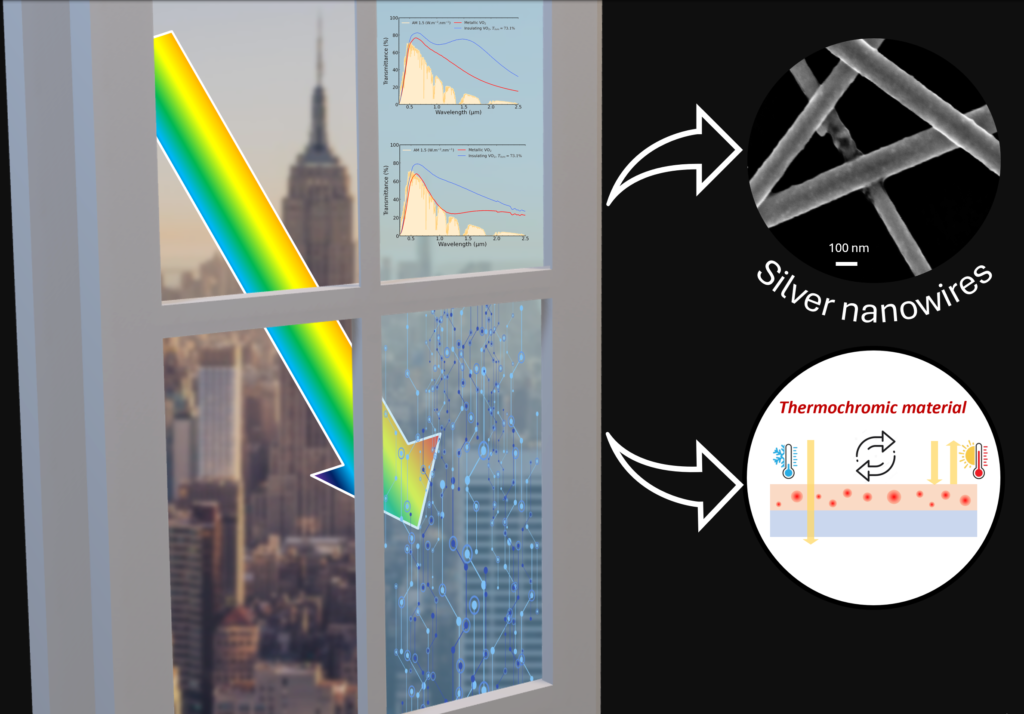
RSC Applied Interfaces publishes interdisciplinary work with an applied focus, which can be read for free here. To celebrate the excellent articles that have been published so far in our journal, we asked some of our authors to discuss their work in more detail.
In this post, we hear from Amaury Baret at University of Liège, Belgium, as they discuss their recently published article entitled ‘Low-emissivity fine-tuning of efficient VO2-based thermochromic stacks with silver nanowire networks’.
Discover the full article here
Low-emissivity fine-tuning of efficient VO2-based thermochromic stacks with silver nanowire networks
Amaury Baret, Ambreen Khan, Aline Rougier, Daniel Bellet and Ngoc Duy Nguyen
RSC Appl. Interfaces, 2025, 2, 94-103. DOI: 10.1039/D4LF00234B

Meet the author
I am a PhD researcher in physics at the University of Liège (ULiège), working under the supervision of Prof. Nguyen, head of the SPIN (Solid State Physics, Interfaces and Nanostructrures) research group. Our research focuses on the physics of materials for energy applications. This highlighted work has been performed within the framework of the INSTEAD project. This collaborative effort is funded by the European M.ERA-NET program and brings together with ULiège a consortium of four partners contributing with their expertise to the development of new materials for smart windows : LMGP Grenoble INP, Université de Grenoble Alpes (Prof. D. Bellet); ICMCB, Université de Bordeaux, (Dr. A. Rougier); Middle East Technical University in Turkey, (Prof. H. Emrah Ünalan).
About the INSTEAD Project
The INSTEAD project aims to develop innovative coatings with advanced functionalities, particularly through the use of heterostructures that combine different materials, including chromogenic compounds. These materials have the potential to dynamically regulate their properties in response to environmental changes, making them highly promising for energy-efficient applications such as smart windows. Additionally, this project explores the incorporation of silver nanowire networks into these complex material stacks, utilizing them as transparent electrodes for electrochromic materials. In the discussed paper, we also investigate their potential as low-emissivity coatings for thermochromic stacks, highlighting their multifunctional role in enhancing the performance of thermochromic stacks for window panes. Our work within this project is part of a broader, coordinated effort to understand and optimize these materials through theoretical and experimental approaches.
What Excites Me About This Research
Working in the field of energy materials is incredibly rewarding, as it allows me to contribute—however modestly—to addressing pressing global challenges. I find great satisfaction in working on abstract physical concepts that have tangible real-world applications. From a scientific perspective, one of the most exciting aspects of this work is the ability to explore complex physical interactions within heterostructure coatings, shaped by both material composition and morphological features. One of the central challenges in our field lies in reconciling two typically opposing properties: electrical conductivity and optical transparency. This trade-off is clearly illustrated by the contrasting behavior of metals, which are excellent conductors but optically opaque, and dielectrics, which are often transparent but insulating. Our research leverages computational modeling to gain deeper insights into these interactions, providing a cost-effective means of understanding their behavior at a fundamental level and paving the way for material-efficient application designs. The coupling of multiple physical phenomena within these materials also opens up fascinating discussions and challenges, making the research both stimulating and impactful.
The Challenges We Face
One of the most challenging aspects of this work lies in interpreting and comparing simulation results with experimental data and existing literature. Ensuring that our models accurately capture the intricate behaviors of these materials requires a careful balance of theoretical insight and empirical validation. Overcoming these challenges is an integral part of the scientist’s work, pushing us to refine our approaches and deepen our understanding of the physical mechanisms at play. Of course, these challenges are not just obstacles but the very essence of scientific research—they fuel our curiosity, drive our passion, and push us to expand, even marginally, the boundaries of human knowledge.
What’s Next?
As part of my ongoing PhD research, I will continue exploring additional physical mechanisms within these materials, with a particular focus on their thermal emissivity properties, a subset of phenomena related to the interaction between matter and electromagnetic radiations. This aligns with the perspectives outlined in our recent publication, where we discuss strategies for optimizing the balance between optical transparency and electrical conductivity. After completing my PhD, I intend to continue conducting research and will therefore be looking for postdoctoral opportunities to further develop my expertise in this area.

